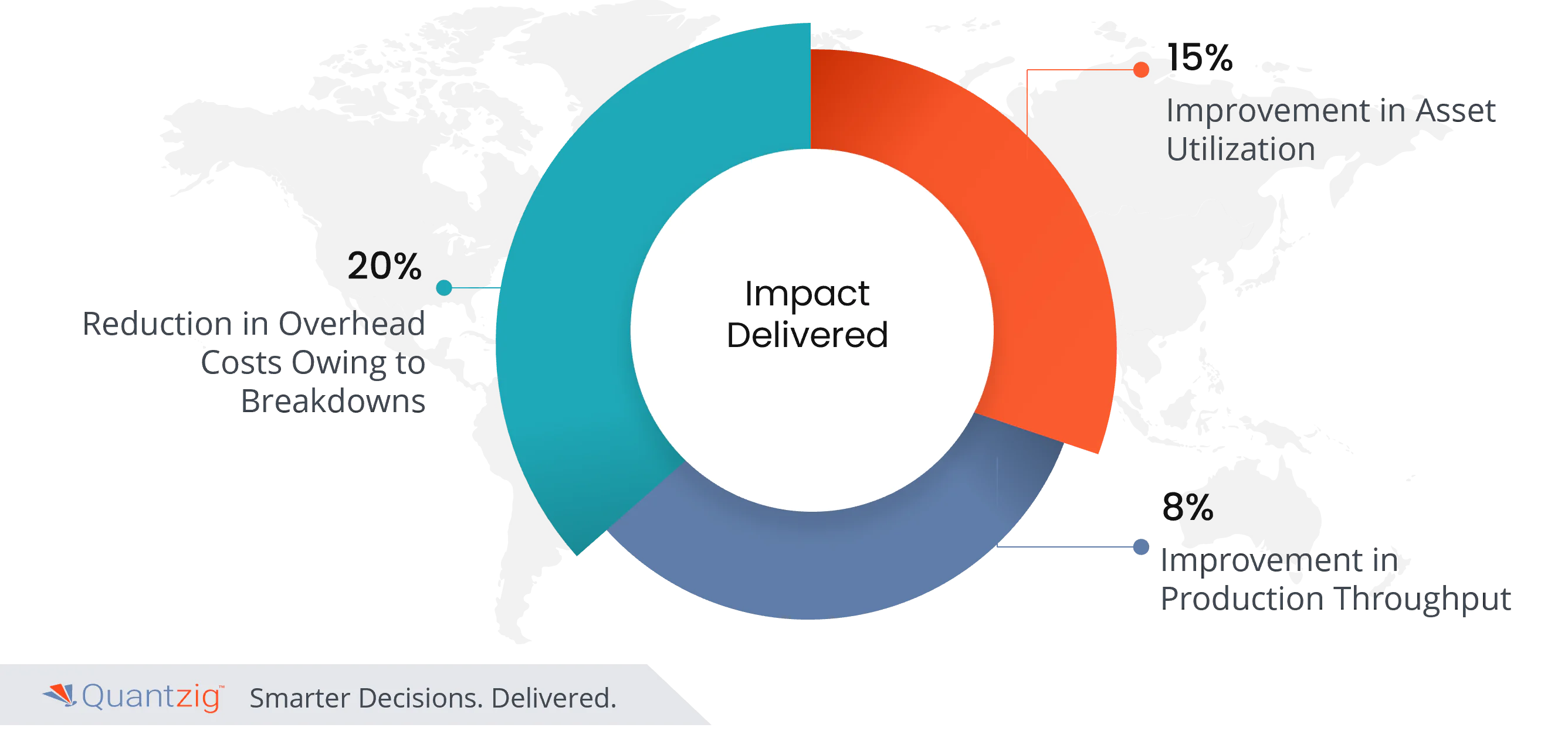
Table of Contents
Summary
Client: A leading manufacturer of heavy machinery, machine components, and engines.
Challenges: The client’s manufacturing operations suffered from underutilized assets, resulting in lower productivity and increased costs. The existing production scheduling process was manual and lacked optimization, leading to inefficiencies, longer lead times, and missed delivery deadlines. The client’s products had diverse specifications and configurations, making it challenging to optimize production schedules and allocate resources effectively.
Solutions: Quantzig conducted a comprehensive analysis of the client’s manufacturing operations, including asset utilization, production capacity, and constraints. Our robust capacity planning strategy helped the client to strike a balance between underutilization and overload, minimizing breakdowns and ensuring smoother operations. The advanced production scheduling algorithms created by our experts considered various factors, such as asset availability, product specifications, and customer demands. These algorithms optimized the production schedules to maximize asset utilization, minimize downtime, and reduce lead times. Our team implemented real-time monitoring and capacity planning to track production progress, identify bottlenecks, and make timely adjustments to production schedules.
Impact Delivered
All of the above initiatives resulted in:
- 20% reduction in overhead costs owing to breakdowns
- 65% reduction in asset overutilization
- 34% increase in production output
Industry Overview
- The heavy machinery manufacturing industry in the USA is a vital factor that contributes significantly to the country’s economy, employs a substantial workforce, and serves diverse domestic and international markets.
- The industry has witnessed rapid technological advancements, with manufacturers incorporating automation, robotics, IoT (Internet of Things), and other cutting-edge technologies into their machinery.
- The heavy machinery industry in the USA is subject to various regulations, including safety standards, emissions controls, and environmental regulations. Compliance with these regulations is essential for manufacturers to ensure the quality and safety of their products.
- Capacity planning plays a crucial role in the heavy machinery industry in the USA, as it allows companies to optimize their production schedules, ensuring that they have the right amount of machinery and resources to meet the market demand. Additionally, it allows manufacturers to proactively identify potential bottlenecks, plan for maintenance and downtime, minimize disruption, enhance asset utilization, and ensure continuous production.
About the Client
- A leading industrial manufacturer, headquartered in the USA, faced challenges with a complex manufacturing process across multiple sites.
- The client operated more than 10 manufacturing sites, each with a substantial number of machine equipment. Many of the machines were either underutilized or overloaded, resulting in frequent breakdowns and the need for costly replacements.
- The lack of optimal utilization of the machines impacted overall production efficiency and increased maintenance and replacement costs. Capacity planning became crucial to optimize machine performance, increase asset utilization, balance workloads, and reduce downtime for the client’s manufacturing operations.
Challenges
- The client had a diverse product portfolio that showcased their commitment to meeting the varied preferences of their customers. But, it also presented a significant hurdle in the form of demand aggregation and line planning. The client’s dedicated team diligently worked through stacks of order forms, spreadsheets, and notes, meticulously piecing together the puzzle of customer demands. However, the manual process proved time-consuming, prone to errors and struggled to keep pace with the ever-changing market dynamics. As the client’s product offerings continued to expand, the manual approach hindered their ability to respond swiftly to changing market demands.
- Having already lost more than $2 Million due to unplanned machine replacements and unexpected downtimes, our client was on the lookout for an analytics partner to help solve this challenge. The underlying causes that led to these substantial losses were rooted in inefficient maintenance practices, inadequate monitoring of machine performance, and a lack of proactive measures to prevent breakdowns. The client’s reliance on reactive maintenance, where repairs and replacements were made only after equipment failures occurred, proved to be a costly approach that drained financial resources. Furthermore, the unexpected downtimes caused by machine breakdowns impacted supply chain efficiency, inventory management, and customer satisfaction.
- They faced a critical need for a solution that could efficiently aggregate demand from multiple sources and provide optimal line-level plans to streamline their operations. Demand aggregation, a crucial aspect of capacity planning, posed a significant challenge for the client due to the complexity of their supply chain and the diversity of their product offerings. The client required a solution that could consolidate demand data from various channels, such as sales forecasts, customer orders, and market trends, to provide a comprehensive view of their demand landscape. Effective capacity planning became essential to ensure that production lines were optimally utilized, resources were allocated efficiently, and customer demands were met timely.
Solutions
- To improve the entire capacity planning process, we implemented three modules: demand forecasting, resource allocation, and performance monitoring. By accurately predicting demand, optimizing resource allocation, and monitoring performance in real time, our solution enabled the client to make informed decisions, avoid underutilization or overload, and ensure a more efficient production process.
- The capacity planning simulator created by Quantzig utilized historical data, machine performance metrics, and other relevant factors to predict the available capacity at the asset and technology level. By simulating various scenarios and considering factors such as machine downtime, maintenance schedules, and production constraints, the simulator provided accurate insights into the client’s capacity landscape. The data-driven nature of the simulator provided the client with a dynamic and flexible tool to explore different “what-if” scenarios.
- Quantzig’s capacity planning solution enabled the client to optimize their capacity by considering factors such as increasing or decreasing the run rate and maintenance change over time in response to fluctuating demand requirements. By analyzing historical data, production rates, and maintenance schedules, we developed algorithms that dynamically adjusted capacity utilization to align with changing demand patterns. By incorporating run rate adjustments and maintenance changeover time into their capacity planning strategy, the client achieved better resource allocation, improved asset utilization, and enhanced operational efficiency.


